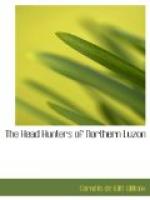But at last we threaded our way down, and, turning sharp to the right, rode out on the small plateau that is Banawe, to be saluted and escorted by the Constabulary Guard and to be received by the shouts of thousands. They at once opened on us with speeches, but these were markedly fewer here than farther south. The quarters of the Constabulary officers were hospitably put at our disposition, and our first enjoyment of them was the splendid shower.
Banawe stands at the head of a very deep valley, shut in by mountains on three sides; the stream sweeping the base of the plateau breaks through on the south. This plateau rises sharply from the floor of the valley; in fact, it is a tongue thrust out by the neighboring mountain, and forms a position of great natural strength against any enemy unprovided with firearms. Across the stream on the east mount the rice-terraces over a thousand feet above the level of the stream; a stupendous piece of work, surpassed at only one or two other places in Luzon. Elsewhere we saw terraces higher up, but none on so great a scale, so completely enlacing the slope from base to crest. The retaining walls here are all of stone, brought up by hand from the stream below. This stream makes its way down to the Mayoyao country, and I was told that the entire valley, thirty-five or forty miles, was a continuity of terraces. Indeed, it requires some time and reflection to realize how splendid this piece of work is: it is almost overwhelming to think what these people have done to get their daily bread. In contemplation of their successful labors, one is justified in believing that, if given a chance, they will yet count, and that heavily, in the destinies of the Archipelago.
Banawe was first visited by Mr. Worcester in 1903, coming down from the north with a party of Igorots. At the head of the pass he was met by an armed deputation of Ifugaos, who came to inquire the purpose of his visit. Was it peace or was it war? He could have either! But he must decide, and immediately. Assured as to the nature of the visit, the head man then gave Mr. Worcester a white rooster, symbol of peace and amity, and escorted him in. But the accompanying Igorots came very near undoing all of Mr. Worcester’s plans. Not only were they shut in during their stay, an obvious and necessary condition of good order and the preservation of peace, but, on Mr. Worcester’s asking food for them, they were told they could have camotes, but no rice; that rice was the food of men and warriors, and camotes that of women and children, and that the Igorots were not men. This almost upset the apple-cart, for the Igorots in a rage at once demanded to be released from their confinement so as to show these Ifugaos who were the real men. But counsels of peace prevailed. In fact, it is a matter of astonishment that Mr. Worcester should be alive to-day, so great at the outset was the danger of personal communication with the wild men of Luzon. [30] It was not always a handsome white rooster, in token of peace, that was handed him; sometimes spears were thrown instead. However, on this trip of ours he got a whole poultry-yard of chickens, besides eggs in every stage of development from new-laid to that in which one could almost feel the pin-feathers sticking through the shell.




